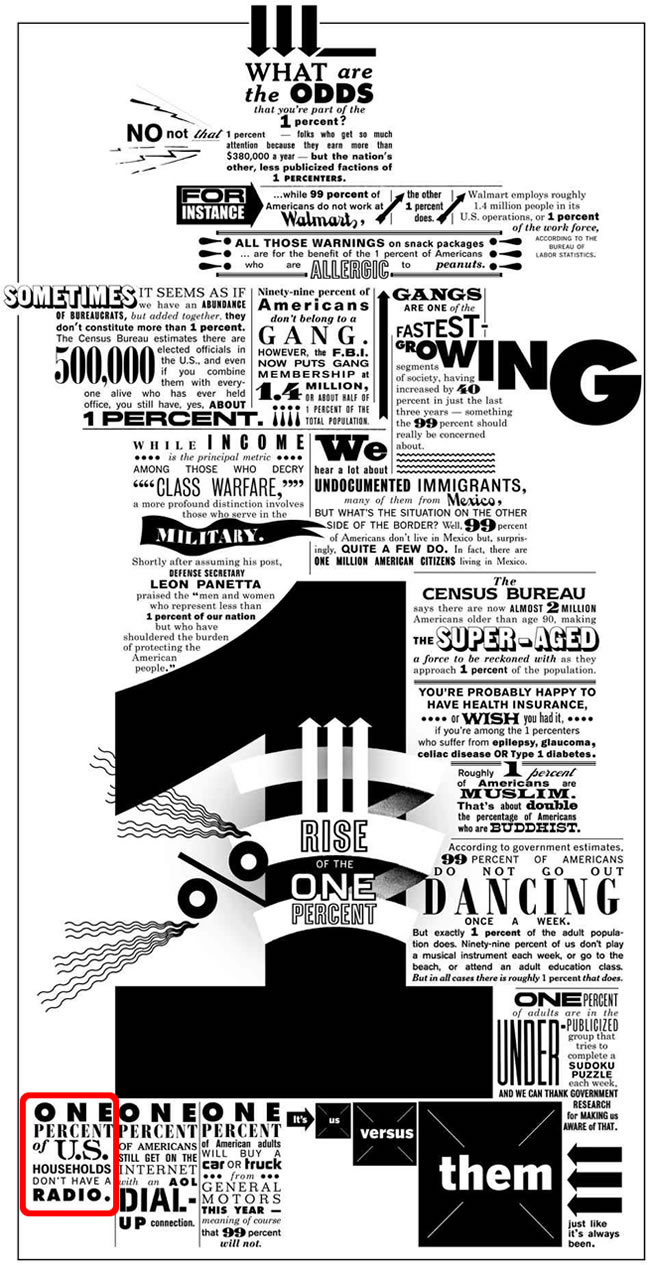There’s been a lot of talk about our divided nation. In an effort to showcase a very different 1%, New York Times writers Peter Funt and Martin Venezky put together a clever infographic that appears below.
It’s fun, fascinating at times, and a clever way to talk about true minorities in this country – from dancers to gang members. But if you read all the way down to the bottom, you’ll see I put a red box around something that is very significant about this infographic:
One percent of U.S. households don’t have a radio.
So “the rest of us” is essentially the rest of the population – the 99% that do have a radio in their homes.
A little “back of the napkin” math is revealing.
A look at the U.S. Census website tells us there are 114,235,996 households in the United States with an average of 2.59 people per household. When you subtract the 1% of households that don’t have a radio, it nets out to 113,093,636 household with a radio – or a net potential reach of 292,912,517 people. Now we know they don’t all listen to the radio, but I like nearly 293 million people as a potential cume, don’t you?
Especially when you compare it with Sirius XM’s 21.9 million subscribers amassed over a decade (and now they’re raising the rates).
Or Pandora with 125,000,000 registered users in the U.S. (49 million of whom are active).
So, 99% reach, multi-location accessibility, no instruction manual, no subscription fees.
All radio has to do is be sure to provide and create content that compels usage.
We’ve done that for decades, but even with a huge lead, there’s never been more reasons and a more critical time to be investing in programming – great entertainment and information content.
Let’s get to work.
- What To Do If Your Radio Station Goes Through A Midlife Crisis - April 25, 2025
- A 2020 Lesson?It Could All Be Gone In A Flash - April 24, 2025
- How AI Can Give Radio Personalities More…PERSONALITY - April 23, 2025





Interesting stats. I dont mean to be a wet blanket, but I fear those radios have lost their cool factor. Could it simply be an out-dated tech appliance? I remember being a 10 year old that couldnt wait to afford a pocket AM transistor radio, so I could take my favorite music to school with me.
Point well taken – most radios have a decidedly retro look. But their ubiquity is an asset and most have radios built into other devices (clock radio, etc.). Always appreciate you chiming in, Andy.
Radio is using its reach numbers the way a drunk uses a lamp post…for support, rather than illumination (to paraphrase GK Chesterton). Everyone associated with media buying knows of radio’s reach and no one seems to care, yet radio has continued to pound away at it almost non-stop for at least 35 years. Even a stopped clock is right twice a day yet the reach message hasn’t landed once in all that time. What would a good ad man, or radio seller advise a client who used the same message for 35 years with no measurable results? What would radio say to a prospect who asked, “…you’ve been hammering home the reach story since the 70s and the HD radio story for ten years with zero success in selling either. Why should I use radio to sell my product?” The answer is that radio is great at selling products, but no medium, no matter how compelling can sell something for which there is no demand. Trying to do it makes radio look out of touch and ineffective at a time when it can ill afford it.
Reach? Most households also have a plunger, a bottle of hydrogen peroxide and a funnel – owning a device isn’t the same as using it. People still use radio a lot, but here’s the red flag: Virtually everyone owns a radio, yet almost 50 million people go to considerable trouble (compared to tuning to a radio station) and over 20 million to considerable expense (Sat. radio) rather than listen to that radio.
“…there’s never been more reasons and a more critical time to be investing in programming – great entertainment and information content…”
I couldn’t agree more, its just that I’m having trouble coming up with the top 5 examples…………………….
Bob, I KNEW when I wrote this post that you would offer a comment. And I concur that reach alone does not a successful venture make. That is why I wrote it as potential – I would rather be that medium that everyone can receive and is simple to operate than one that contains many hoops. Without great programming content, the reach doesn’t matter. But from talk show hosts to play-by-play sports to great music DJs to stations that are truly rooted to their communities, I can easily come up with more than five examples. But it’s more difficult to come up with 100, and that’s a problem. The 50 million people who turn to Pandora and the 20 million who buy satellite radio may not necessarily go there at the exclusion of broadcast radio, but the fact they’re seeking out alternatives does say something about the quality of the broadcast radio medium today. Let’s use our inherent strengths to build a better future. Thanks for contributing.
The clock is ticking on the hoops advantage and once that goes away, so will much of the reach advantage. Radio needs to start investing and innovating before that happens. Compare the number of stories in the trade press about creativity and innovation to the number of stories about people getting fired. Those numbers need to reverse before radio and all the Webcasters are both buttons on the same touch screens imported from Detroit.
I feel the pressure every time I get in my Ford Edge and look at the Sync screen.